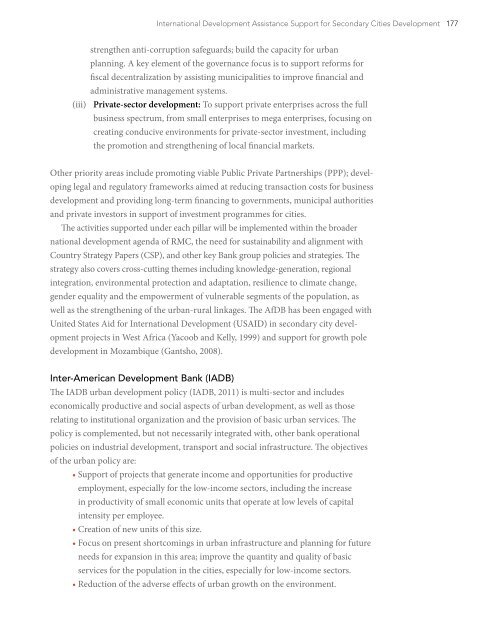DYhWN
DYhWN
DYhWN
Create successful ePaper yourself
Turn your PDF publications into a flip-book with our unique Google optimized e-Paper software.
International Development Assistance Support for Secondary Cities Development 177strengthen anti-corruption safeguards; build the capacity for urbanplanning. A key element of the governance focus is to support reforms forfiscal decentralization by assisting municipalities to improve financial andadministrative management systems.(iii) Private-sector development: To support private enterprises across the fullbusiness spectrum, from small enterprises to mega enterprises, focusing oncreating conducive environments for private-sector investment, includingthe promotion and strengthening of local financial markets.Other priority areas include promoting viable Public Private Partnerships (PPP); developinglegal and regulatory frameworks aimed at reducing transaction costs for businessdevelopment and providing long-term financing to governments, municipal authoritiesand private investors in support of investment programmes for cities.The activities supported under each pillar will be implemented within the broadernational development agenda of RMC, the need for sustainability and alignment withCountry Strategy Papers (CSP), and other key Bank group policies and strategies. Thestrategy also covers cross-cutting themes including knowledge-generation, regionalintegration, environmental protection and adaptation, resilience to climate change,gender equality and the empowerment of vulnerable segments of the population, aswell as the strengthening of the urban-rural linkages. The AfDB has been engaged withUnited States Aid for International Development (USAID) in secondary city developmentprojects in West Africa (Yacoob and Kelly, 1999) and support for growth poledevelopment in Mozambique (Gantsho, 2008).Inter-American Development Bank (IADB)The IADB urban development policy (IADB, 2011) is multi-sector and includeseconomically productive and social aspects of urban development, as well as thoserelating to institutional organization and the provision of basic urban services. Thepolicy is complemented, but not necessarily integrated with, other bank operationalpolicies on industrial development, transport and social infrastructure. The objectivesof the urban policy are:• Support of projects that generate income and opportunities for productiveemployment, especially for the low-income sectors, including the increasein productivity of small economic units that operate at low levels of capitalintensity per employee.• Creation of new units of this size.• Focus on present shortcomings in urban infrastructure and planning for futureneeds for expansion in this area; improve the quantity and quality of basicservices for the population in the cities, especially for low-income sectors.• Reduction of the adverse effects of urban growth on the environment.


